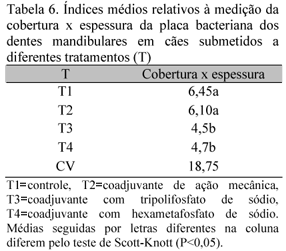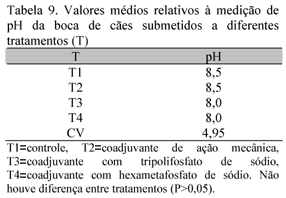The use of coadjutants in the decrease of the bacterial plate and formation of the dental calculus was evaluated in 16 dogs. The experimental design was randomized with four treatments (T) and four repetitions. The treatments were the following: 1- control; 2- coadjutant 1 (one) with mechanical action; 3- coadjutant 2 (two) with tripolyphosphate of sodium and 4- coadjutant 3 (three) with hexametaphosphate of sodium. After seven days of adaptation, on the day previous to the beginning of the treatments, the animals were submitted to the removal of dental calculus and after twenty-one days of treatment a measurement of the bacterial plaque formed through the use of markers (fucsin). The coadjutant only with mechanical action was not effective in delaying the appearance of the bacterial plaque. The coadjutant containing polyphosphates presented an effective and significant action decreasing the formation of the dental calculus.
dog; sodium tripolyphosphate; sodium hexametaphosphate; dental calculus









